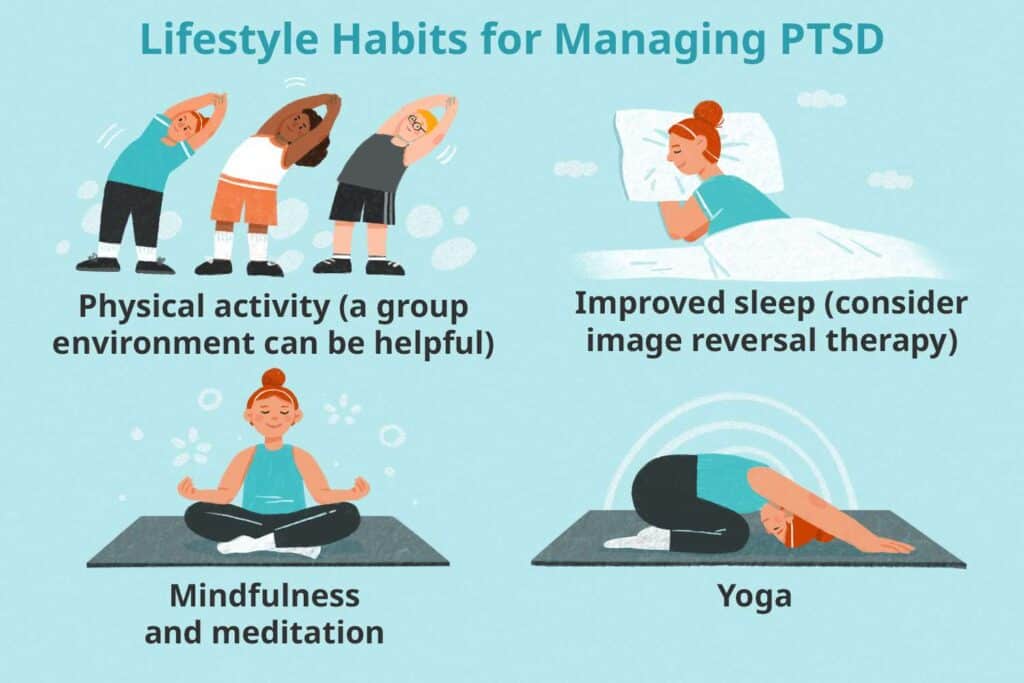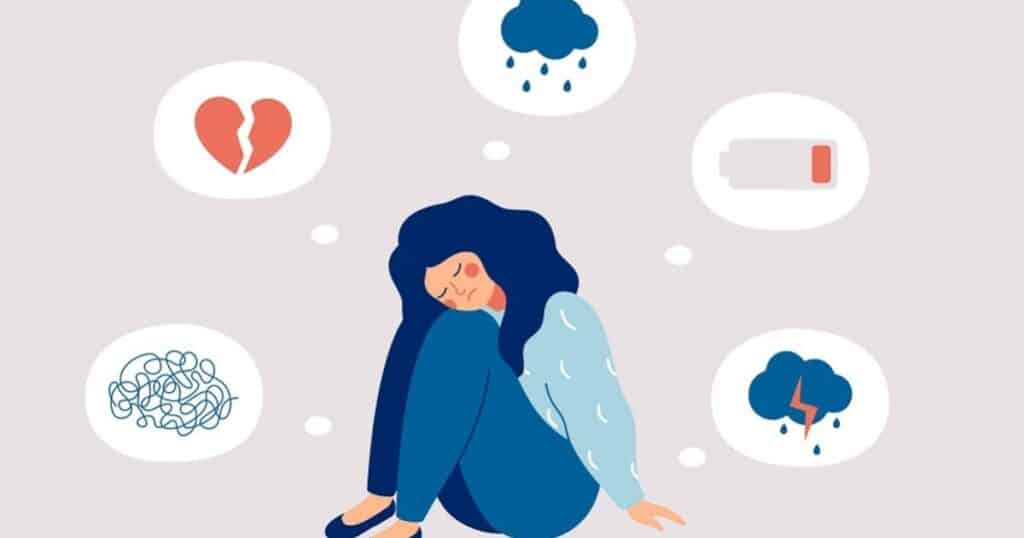Post-traumatic stress disorder (PTSD) is a mental health condition triggered by experiencing or witnessing a traumatic event. It is characterized by intense, distressing thoughts, flashbacks, and nightmares related to the trauma, often disrupting daily life. While fear and shock are normal responses to trauma, PTSD arises when these reactions persist beyond a month and interfere with a person’s ability to function.
Each year, PTSD affects millions worldwide. In the United States alone, around 12 million adults experience PTSD annually. Globally, it is estimated that 6% of people will experience PTSD at some point in their lives. This article explores the causes, symptoms, risk factors, treatments, and coping mechanisms for PTSD while emphasizing the importance of support and understanding.
What is PTSD?

PTSD is a psychological response to trauma. People with PTSD may feel as though they are reliving the event, experiencing flashbacks or nightmares that evoke the fear and helplessness they initially felt. It is important to note that while most people encounter some level of distress after trauma, not everyone develops PTSD.
Key Facts About PTSD
- PTSD is more common in women than men, often linked to different types of trauma.
- Symptoms can appear immediately or months (even years) after the traumatic event.
- Without treatment, PTSD can persist for years, negatively impacting mental, physical, and emotional health.
Types of PTSD
Mental health professionals classify PTSD into several subtypes, recognizing that not all experiences of the disorder are the same.
| Type | Key Features |
|---|---|
| Complex PTSD | Associated with prolonged trauma, often during childhood, and includes emotional dysregulation. |
| Dissociative PTSD | Features dissociative symptoms such as feeling disconnected from oneself or the environment. |
| Delayed Expression PTSD | Symptoms appear six months or more after the trauma. |
| Birth Trauma | Develops after a traumatic childbirth experience. |
| PTSD in Children | Recognizes age-specific symptoms like bedwetting, acting out the event, or becoming overly clingy. |
Symptoms of PTSD
PTSD symptoms are categorized into four main groups, each contributing to the distress and challenges individuals face.
1. Intrusion Symptoms
Intrusive symptoms involve involuntary reliving of the trauma, often making individuals feel as though the event is happening again. Examples include:
- Flashbacks that are vivid and emotionally intense.
- Recurring nightmares about the traumatic event.
- Extreme emotional distress or physical reactions when reminded of the trauma.
2. Avoidance Symptoms
Avoidance symptoms reflect efforts to steer clear of reminders of the event:
- Avoiding conversations, places, or people connected to the trauma.
- Suppressing thoughts and feelings about the event.
3. Negative Changes in Mood and Cognition
These changes impact a person’s emotions and thought patterns:
- Persistent feelings of guilt, shame, or blame.
- Difficulty remembering parts of the traumatic event.
- Loss of interest in previously enjoyable activities.
- Feeling detached from loved ones or society.
4. Arousal and Reactivity Symptoms
These symptoms involve heightened emotional and physical responses:
- Irritability or sudden anger outbursts.
- Difficulty concentrating or focusing on tasks.
- Sleep disturbances, such as insomnia or restless sleep.
- Hypervigilance or being easily startled.
Physical Symptoms
PTSD often manifests physically as well, with individuals experiencing:
- Frequent headaches, stomach issues, or chest pain.
- Dizziness or shaking during moments of heightened anxiety.
- Fatigue from poor-quality sleep or insomnia.
PTSD in Children and Adolescents
PTSD affects children and teens differently than adults. Younger children may:
- Regress in development, such as wetting the bed after being toilet trained.
- Reenact the trauma during play or storytelling.
- Become overly clingy or fearful.
In older children and teens, symptoms may include:
- Aggressive or impulsive behavior.
- Feelings of guilt for not preventing the event.
- Difficulty maintaining friendships or academic performance.
Causes and Risk Factors
Causes of PTSD
PTSD can develop after a variety of traumatic events, including:
- Military Combat: Veterans are particularly susceptible due to prolonged exposure to life-threatening situations.
- Natural Disasters: Survivors of hurricanes, earthquakes, or wildfires may experience PTSD.
- Violence and Abuse: Sexual assault, domestic violence, and childhood abuse are common triggers.
- Loss of a Loved One: Unexpected or violent deaths of close relatives can lead to PTSD.
- Accidents: Severe car crashes or workplace injuries may also contribute.
Risk Factors
While trauma is the primary cause, other factors increase the likelihood of developing PTSD:
- Pre-existing Mental Health Conditions: Anxiety or depression can make individuals more vulnerable.
- Lack of Social Support: Feeling isolated after the event can intensify symptoms.
- Severity of Trauma: Events involving life-threatening situations are more likely to result in PTSD.
- Childhood Experiences: Those who faced adversity or neglect in childhood are at higher risk.
Impact of PTSD on Relationships and Intimacy

PTSD can profoundly affect relationships, often making it difficult to build trust and maintain emotional connections. Common challenges include:
- Emotional Detachment: Individuals may struggle to open up or express affection.
- Anger Outbursts: Heightened irritability can lead to conflicts with loved ones.
- Mistrust: Survivors of abuse or violence may find it hard to feel safe in relationships.
- Sexual Intimacy Issues: Trauma, particularly involving sexual violence, can make physical closeness difficult.
Supportive partners and therapy can help bridge these gaps, fostering healing and understanding.
Diagnosis of PTSD
Diagnosing PTSD involves a comprehensive evaluation by a mental health professional. Key steps include:
- Screening: A 45–60 minute session to assess symptoms and their impact on daily life.
- DSM-5 Criteria: Symptoms must meet specific guidelines, including persistence for over a month and significant disruption to work or relationships.
- Differentiating PTSD from Other Conditions: Conditions like depression, anxiety, or acute stress disorder (ASD) may share overlapping symptoms.
Treatment Options for PTSD
PTSD treatment is tailored to individual needs, often combining therapy, medication, and self-care.
1. Psychotherapy
Therapy helps individuals process their trauma and develop coping strategies. Popular approaches include:
- Cognitive Processing Therapy (CPT): Focuses on reframing negative thoughts about the trauma.
- Prolonged Exposure Therapy: Gradually exposes individuals to memories or triggers in a safe environment to reduce fear.
- Eye Movement Desensitization and Reprocessing (EMDR): Combines trauma recall with guided eye movements to lower emotional distress.
2. Medications
Antidepressants like selective serotonin reuptake inhibitors (SSRIs) can help manage symptoms. Common options include:
- Sertraline
- Paroxetine
- Fluoxetine
3. Emerging Treatments
Experimental therapies are offering new hope for PTSD treatment:
- MDMA-Assisted Therapy: Early studies show promise in helping individuals feel safe while processing trauma.
- Virtual Reality Therapy: Simulated environments can help veterans and others reframe their trauma.
Self-Care Tips for Coping with PTSD
Active coping strategies play a vital role in recovery. Here are practical tips for managing symptoms:
| Tip | How It Helps |
|---|---|
| Educate Yourself | Understanding PTSD empowers individuals to manage symptoms effectively. |
| Build a Support Network | Family, friends, or support groups provide emotional encouragement and perspective. |
| Practice Relaxation Techniques | Deep breathing, meditation, and mindfulness reduce stress and anxiety. |
| Stay Physically Active | Exercise releases endorphins, improving mood and energy levels. |
| Set Realistic Goals | Breaking tasks into smaller, manageable steps restores confidence and routine. |
| Engage in Enjoyable Activities | Hobbies or creative pursuits can distract from intrusive thoughts and boost happiness. |
| Seek Professional Help | Therapists can provide personalized strategies and guidance for recovery. |
Support and Resources for PTSD
If you or someone you know is struggling with PTSD, help is available.
Emergency Help
- National Suicide Prevention Lifeline: 1-800-273-TALK or 988
- National Domestic Violence Hotline: 1-800-799-SAFE
Specialized PTSD Support
- Veterans Affairs PTSD Help Line: Resources tailored to veterans and active-duty military personnel.
- Local Therapists: Use directories like Psychology Today to find experienced mental health professionals.
Authentic Sources for PTSD Information
For reliable and up-to-date information about PTSD, consult these trusted sources:
- National Institute of Mental Health (NIMH): www.nimh.nih.gov
- American Psychological Association (APA): www.apa.org
- Veterans Affairs National Center for PTSD: www.ptsd.va.gov
- World Health Organization (WHO): www.who.int
- Substance Abuse and Mental Health Services Administration (SAMHSA): www.samhsa.gov
Conclusion
PTSD is a complex but treatable condition. With the right combination of therapy, medication, and self-care, individuals can regain control over their lives and find hope for the future. By fostering awareness, breaking stigma, and offering support, we can create a society where those affected by PTSD feel understood and empowered to seek help. Whether you’re a survivor, a loved one, or a community member, understanding PTSD is the first step toward healing and resilience.


